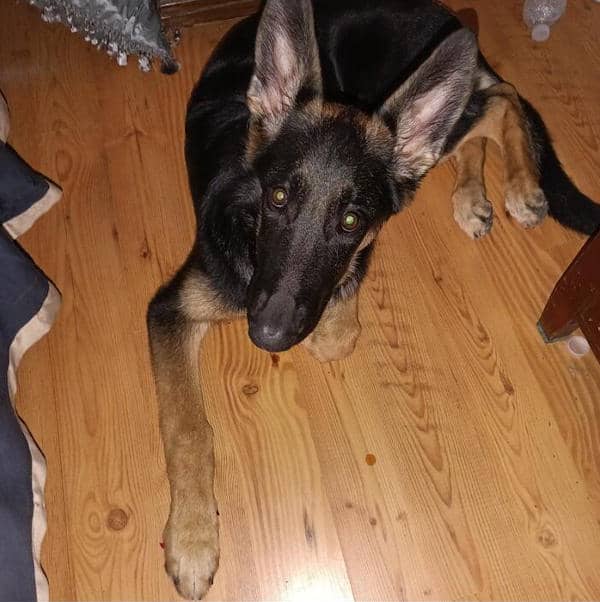NextDoor is a social media app with a focus on your own neighborhood. I occasionally scan it for news in the area, and for posts which mention dogs. A few times I’ve connected with people having scared dogs and helped them, but we also get quite a few posts on dog attacks and other related concerns. The first episode focused on a dog attack.
This episode has a much deeper emotional undertone, as it deals with the possibly unnecessary suffering and death of a dog, and especially the responses from both the person responsible and many other people.
I’ll first provide some background on accurate and necessary precautions for the parvo virus with dogs. You may notice that, as with many other such issues, there will be differences even between authoritative sites, especially from different simplifications made for the typical dog owner. There you may find the Merck Manual and Cornell University a bit more accurate.
After that, we’ll turn to the NextDoor posts to show both the difficulty in preventing false information from being passed, and the typical responses on social media when asking for any details.
Parvo and Prevention
During the 2020 Pandemic many more people were working from home for months, and enough additional people then decided to adopt animals, causing some shelters to run quite lean for a time. To make up for this, more people than usual turned to Craig’s List and similar networks or back-yard breeders or individuals to find a free or low-cost pet to adopt.
However, unlike most shelters and rescues, many of these sources for pets either don’t know or simply don’t care about vaccinations and medical care. With any dog you adopt from an actual shelter, you can reasonably expect to receive a vaccination shot card and any medical records. Some shelters will also give you a complementary wellness card for a local vet, and suggest you quickly establish which vet you will use.
But, many of these other sources will give you little or nothing. In those cases, one could make the case that new adopters with little or no prior experience with dogs simply will not know what questions to ask, or what actions to immediately take, for the dog’s health and well being.
However, adopting an animal is a responsibility that should have some planning and research. And a simple call to most shelters, rescues, or some veterinary offices will often give you some starting advice. Or, these days, there are more than a few places to find this general information on the internet.
American Animal Hospital Association – Vaccination recommendations
American Veterinary Medical Association on Canine Parvovirus
American Kennel Club
Pets WebMD – Schedules for cats and dogs
Todays Veterinary Practice
Veterinary Partner – Parvovirus: vaccination and prevention
Global Veterinary community – Vaccination Guidelines
And an overall description and summary of the history of the canine parvovirus can be found in Veterinary Partner – Parvovirus in Dogs.
There are even some guarantees
Unfortunately, no vaccine is perfect. The latest figures appear to show about a 3.3% failure with the parvo vaccine.
Canine parvovirus vaccination and immunisation failures
Our 7th month old puppy got Parvo even though he was fully vaccinated. Thank God we noticed the symptoms and got him help immediately. Got reimbursed $ from vaccine manufacturer
Kimberly L.
As an example, here is the Elanco Vaccine Guarantee.
Summary of when vaccinations should be given
As for why very young pups need several doses:
Young puppies are very susceptible to infection, particularly because the natural immunity provided in their mothers’ milk may wear off before the puppies’ own immune systems are mature enough to fight off infection. If a puppy is exposed to canine parvovirus during this gap in protection, it may become ill. An additional concern is that immunity provided by a mother’s milk may interfere with an effective response to vaccination. This means even vaccinated puppies may occasionally be infected by parvovirus and develop disease. To reduce gaps in protection and provide the best protection against parvovirus during the first few months of life, a series of puppy vaccinations are administered. Puppies should receive a dose of canine parvovirus vaccine between 14 and 16 weeks of age, regardless of how many doses they received earlier, to develop adequate protection.
American Veterinary Medical Association on Canine Parvovirus
Beginning as early as 6 wk of age, administer sequential doses of a combination vaccine at an interval of 2 to 4 wk until at least 16 wk of age.
American Animal Hospital Association

Dogs that are ~16 wk of age when presented for initial vaccination should receive a second dose 2 to 4 wk later
The dog should then have some isolation or restricted activity until at least one week after the last dose. While this is the perhaps the safest course, protection might occur a little earlier, as shown next.
It has been suggested that the presence of maternally acquired CPV antibodies may interfere with the effectiveness of vaccination in puppies <10 weeks old. However, current modified-live CPV vaccines are sufficiently immunogenic to protect puppies from infection in the presence of low levels of interfering maternal antibody, and vaccination of 4-week-old puppies with a high antigen titer vaccine results in seroconversion and may decrease the window of susceptibility to infection. Current vaccine products protect similarly well against CPV-2 as against other strains of the virus.
Merck Veterinary Manual, 2020
What others often do not mention is that much of that early immunity they describe in young pups depends upon maternally acquired CPV antibodies from the mother. Which assumes the mother had been vaccinated or previously infected.
And the Merck Manual here also indicates it is very likely that even young pups are protected from a week or two after the first parvo vaccination. However, this is not likely to be anything that will be formally tested, due to the inherent risk.
Along those same lines, the American Veterinary Society of Animal Behavior (ABSAB) has come out (way back in 2008) with their Position Statement on Puppy Socialization, which suggests starting socialization at about 7 weeks of age, and at least one week after starting their vaccines. Of course, the places they go and dogs they meet during this time should be selected to reduce the risk of disease transmission. Some examples might be selectively limited puppy classes, and avoiding general dog parks and pet food stores during this period.
And for parvo lasting in the environment
Yes, if you browse the web, you can find some really scary stuff about the parvo virus lasting just about everywhere and for years and years. However, let’s instead try an authoritative source on this.
The tiny parvovirus is extraordinarily hardy. They are capable of surviving for months outside an animal, even through the winter, and are resistant to most household cleaning products. Infected dogs can shed vast numbers of viruses, making it difficult to disinfect an area once it has been exposed to an infected dog. These facts highlight the importance of isolating any dog that is infected with CPV from other dogs. Given the fact that most environments (including dog parks, lawns, and even homes) are not cleaned with disinfecting products regularly, a puppy can be exposed to CPV without any warning, making the vaccine protection all the more important.
If your home and yard have been contaminated by an infected dog, there are steps you can take to disinfect them before introducing a new dog or puppy. Despite its relative resistance to cleaning agents, we do know that CPV can be inactivated by bleach. Cleaning with a solution of one part bleach mixed with approximately 30 parts water is an acceptable method for disinfecting any indoor area (including bedding, food/water bowls, and all surfaces) that once housed an infected dog. There is evidence suggesting that CPV loses some of its ability to infect an animal after one month in an indoor environment. Outside, you cannot (and should not) bleach your lawn, but rain or watering can dilute the concentration of the virus over time. This dilution, combined with the sanitizing effects of sunlight can bring the numbers of viruses down to an acceptable level in a few weeks.
Cornell University – College of Veterinary Medicine
Keeping this in perspective, where I had lived on the East Coast with moist soil and many plants, I’d expect the virus to persist outside far longer than in New Mexico’s high-desert, with a strong sunlight and little moisture (Merck Veterinary Manual). There are also a few products you could buy to help sanitize the back yard, but little seems to be known on their effectiveness, except for those noted in Sanitizing and Disinfecting the Environment.
NextDoor Post – Parvo Alert

My 6 month old GSD, Sascha, died last night and the vet called to say its was Parvo, after a necropsy. We live on Brenda and walk a 3 block path from 17th to Arlene to Fran And back up Charlene. Someone’s dog has Parvo…my puppy had only had 2 doses of the Parvo shot and died within 48 hours. Please get your dog the shots they need, when they need them and be very careful with what they encounter while on walks, my heart is broken, if it is financial I would be happy to pay for the vet visit for shots, we are a community and we should all went to help each other!
Jennifer V.
While Jennifer is pleading with other people to be careful, what is her message to them? With a pup of that age, 2 doses of the vaccine should have been enough, so what should people do differently?
And just walking outside for 3 blocks, even if an infected dog had also done so days ago, is risky but not that likely to cause an infection. Sure, anything’s possible, but that’s more kennels, houses, and back yards, where the infected dog spent hours and days, which are far more dangerous. Here (in high-desert), a dog walking by spends only seconds at a location, and this is exposed to the sun and weather. You still need to watch, and if you see any diarrhea which is still moist or feces, don’t come anywhere near that.
Of course, if you have no idea about parvo or vaccinations, then you will have no idea what to watch for or why. So, that would be an issue.
While it’s possible for parvo to kill a dog that quickly (2 days), there will typically be some prior symptoms. But, we don’t find out until later if that shot was given during a vet exam, or maybe just a shot clinic. Or if the dog presented with any symptoms at all before she died.
Right, i had no idea, i thought after the first round she was safe and the additional rounds were boosters to keep up with her weight, i hate myself right now
Jennifer V.
But at no point does she ever mention where that idea came from. Nor have I ever heard of boosters given as a dog (or person) gains in weight. If she had her dog in for the shots, why wouldn’t she be talking to the vet about this?
And if she did ask the vet, this would be perhaps the perfect place for Jennifer to explain what had happened and what the vet told her should have been done, but we hear nothing on that.
Jennifer I am so sorry for your loss. Thank you for sharing Sascha’s story with us in hopes of helping other pups.
So sorry for your loss. I am sure she was well loved while she was here. Thank you for being so thoughtful to offer to help those who seem to be uncaring or possibly oblovious to how devastating Parvo can be. Paws up
I’m so sorry for your loss. How devastating. It’s true that puppies that have not been fully vaccinated should not be exposed to areas where other animals may have been.
Dawne W., Glenda S., Theresa B.
From these and other similar responses, it appears clear that people believe Jennifer’s sharing this story will help others. And there’s an emphasis on the dog being fully vaccinated, but nobody at all seems to know or even care what that means.
So sorry that this happened to you. It is a reminder that no dog should be out in public until they’re fully vaccinated with at least 3 to 4 doses. It is so easy to pick up this deadly disease
Ashley M.
And Ashley, of course, has no idea what’s really needed, but that certainly won’t stop her from giving advice. As you read at the start, it’s not simply the number of doses given, and that the real answer is very easy to find out.
And Parvo is everywhere and always?
Parvo is extremely prevalent in New Mexico. My vet advised me to keep my pup indoors until he received the parvo vaccine. I didn’t even take him outside to pee. I’ve had several friends’ pets get parvo from their own yards.
Chris P.
Sure, there are a few places in this state where parvo is very prevalent. But, not in this area. As for dogs getting parvo from peeing in their own back yard, unless you had a previous dog who was sick I can’t even imagine that happening.
That’s terrible! Parvo can live In the yard or on a surface for a long time. Lots of other dogs will get sick if others are walking their dogs.
Heather G.
Oh no not that pretty pup I saw a bunch!! I’m on Brenda too. My dogs have all their shots. I’ve heard Parvo can live in the ground for 10 years.
Joan A.
In order to understand what are reasonable precautions, one would have to first learn that a sick dog simply walking down the street will not leave a deadly trail to infect all other dogs for many months. Sure, if the dog leaves bodily fluids, but not just from their paws on the street. Yes, some caution is still needed, but not hyteria.
So sorry for your loss Parvo is everywhere. That’s why you shouldn’t walk pups In public until fully vaccinated. I have a 15 week pup and I never let him on public ground. I always cringe when I see people taking pup to pup lives places before fully vaccinated.
Cindy D.
While the parvo virus can persist for quite some time, that is far more likely inside in corners and such. Much less likely outside in dry air and sunlight. But very likely in places like pet food shops, where some will strongly advise you to not bring in any unvaccinated dogs.
please no shaming our hard working Vets
Gina J.
And, anything at all which might seem to disagree with or even question anybody else is automatically considered shaming on this social media.
And What Really Happened?
I tried to softly ask when each shot was given, and at what age, and where the dog was adopted from, and got the following reply.
she was born april 8th and we adopted her August 19th, we were told she had her first round at Valley vetco, we brought her to petsmart on tuesday for her second round. She died Thursday. does this clarify the timeline for you. Curious what you are insinuating? Is the world not hard enough as it is? What pound of flesh are you trying to take here?
Jennifer V.
And, here we go again! With the insinuating, pound of flesh, and shaming accusations.
From even those few details, it now seems pretty likely that dog did not come from any shelter or rescue. Instead, she was likely from some individual, possibly off of Craig’s List. There was apparently no shot record or date given, and Jennifer never bothered to call that vet to check the date. If that shot had been given when the pup was much under 16 weeks, then she may have had at worst limited immunity to parvo. Of course, if that first shot had never happened…
Jennifer then waited over a month (Aug 19 – Sept 21) to even see a vet, likely not taking any precautions until then. But, at that point, the dog was already infected and dying, so the parvo vaccine was useless. And another point is a bit odd here.
Most deaths from parvovirus occur within 48 to 72 hours following the onset of clinical signs. If your puppy or dog shows any of these signs, you should contact your veterinarian immediately.
American Veterinary Medical Association
Given that, were any of those symptoms seen? Was she taken immediately back to the vet for treatment, or not? We don’t know what happened then, except that any details which might have helped other people were omitted.
The Advice
From that likely conclusion, I then posted this advice:
While no vaccine is perfect, if they did not know her exact age when given the first dose, they should have advised you to immediately get a second dose, and to severely limit her activity for the next week after, as she may not have ANY immunity. That is why several spaced doses are given to young pups.
At 6 months old, with no clear immunity, she should have had two spaced shots, with restricted activity until a week after. As she was likely already infected, it was simply too late for your shot to have any effect.
General Advice:
If anybody EVER adopts a dog and is only told but not given a shot record, unless you get a confirmation from the attending veterinarian you should not ever take their word for that. Both parvo and distemper can be rapid and deadly.
If a private adoption and you’ve not experienced with dogs, and if a vet appointment takes weeks, call around. Try Watermelon Mountain Ranch or another shelter, and ask them for advice.
Now, I could have added all the easy internet references I gave above, and that you really have a responsibility to become a little familiar with this before adopting a dog. Or at least before months go by. But, I held that back to make the advice a bit softer. And, their first response was:

Jennifer sorry ignore the shamers, you are obviously a loving parents have a beautiful fur baby and we all appreciate your putting it out there for the rest of us who are praying for you and feel for you and your loss
Gina J.
And What are They Really Sad About?
Heartbroken for you!
I’m so sorry for the loss of your fur baby!!
Bless your heart & soul!! Your an amazing human being!!
Diana W., Sharon W., Alisa T.
Let’s start with that nearly everybody (152 comments) felt so very sad for Jennifer. But, nobody else there ever questioned the details to find out what actually went wrong. As for how to avoid this issue, not even a veterinary technician gave any meaningful advice. About the only thing she even said was they are seeing many more parvo cases recently.
Of course, with the pandemic’s effects, that increase in parvo infections could be from many other people following Jennifer’s lead. Jennifer never really made any effort here, and attempted to hide what she did wrong so others could not learn. Then, for that, she ended up with Alisa T. above declaring her an amazing human being.
From all this, it seems likely the entire discourse was all about Jennifer feeling oh, so bad. And that nobody really gave a damn about avoiding the suffering and death the poor dog experienced. To even hint that any person could have possibly done any better would be a case of shaming the person, and it seems that is all that matters to many of those people.
Links I posted about parvo precautions and shot schedules were simply ignored, because that of course would be shaming the vet.
Comes the Name Calling
Gina Jones, Some folks do nothing but troll and poke the bear on posts. Ignoring people like that is hard, but at least it does not give them the satisfaction of any kind of attention, which is what they seek.
Peggy B.
THANK YOU…i wanted to say the equivalent but wasn’t trusting myself to be civil…she called me out for escalating but SHE was the one that took it to an impolite space…im an adult so I typically just keep scrolling past the nonsense of ill mannered people! And I see she continued to call people out and demand vet names…WHATever….I dont need to give her my vets name and Im sure he’d appreciate that!
Gina Jones agreed…i have since researched her trolling history
Jennifer V.
To do something that might provoke someone into becoming angry or causing problems.
To Poke The Bear
Now, taking Peggy B’s claim above, apparently my asking about what went wrong and why the dog died resulted in some of them becoming rather upset, so I guess I did end up poking that bear. But, why not?
Next we have this troll thing.
In internet slang, a troll is a person who posts inflammatory, insincere, digressive, extraneous, or off-topic message in an online community…with the intent of provoking readers into displaying emotional responses or manipulating others’ perceptions.
Wikipedia – Internet Troll
Here, I asked very calm and simple, on-topic questions about what actually happened. I later gave on-topic advice which was factual and could easily be found in authoritative sites, a few of which I also listed.
Alternately, Gina, Jennifer, and others posted purely emotional messages which had no bearing on why the dog died or how to prevent that from happening, but only to provoke emotional responses, with inflammatory name-calling. So, which one of these is the troll?
As for Jennifer’s claim of my demanding vet names, I had only asked her who the dog was adopted from, which she did not answer. I never asked her for the vet name.
Instead, another person first wrote that her vet told her to not take the dog on walks (ever?) as they can still get the parvo virus. I then politely asked which vet said that? Subsequently, it turned out that the woman had only posted part of her vet’s message, which actually was only to not walk the dog outside for a week after her 2nd parvo shot, and that woman then apologized for not making that clear.
The point of this section is that while the actual written text showed their accusations to be false, that really doesn’t matter in social media. Even pointing out in quotes what they previously wrote will just be ignored. Here, the winner is the person having the most supporters who post the most frequent and outrageous comments.
And the Conclusion
In the first episode, social media focused on creating a villain and throwing stones. This time, it’s all about sympathy for a person’s perceived loss, while ignoring why it happened. In both cases, any questions on detail were interpreted as insinuating, shaming, and looking to take pounds of flesh.
And at no point do we ever hear anything to suggest that Jennifer has now learned how to do this better. Instead, it sounds more like most of those people will now go to one extreme or the other, to avoid learning the facts.
For all of the great potential of the Internet to support the spread of knowledge and learning, a large part of the traffic today relates to social media. Episodes such as these are becoming so common that some discussions rapidly become toxic, and both ignorance or lies are rapidly spread. And are then passed on, and on…
